Hair Loss Glossary
Alopecia: Alopecia is the medical term for “hair loss”. Hair loss could be related to Male Pattern Baldness (Androgenic Alopecia), Female Pattern Baldness, Alopecia Areata, Scarring Hair Loss and other medical conditions.
Alopecia Areata: This is a medical condition which can affect otherwise healthy people. The hair usually falls out in round patches and is related to an autoimmune condition in which the body attacks normal hair follicles on the scalp, eyebrows, beard and body. The hair loss usually resolves within a year and may benefit from steroid injections. Hair transplant does not treat this condition.
Androgenetic Alopecia: This is the medical term for “Male Pattern Baldness”. Hair is lost in a well-defined pattern beginning above the temples towards the top of the head. It may also involve the crown. This may be related to other medical conditions such as coronary heart disease, prostate enlargement, diabetes, obesity and hypertension.
Women can suffer from this condition, though they usually experience thinning, no change in hairline and rarely total baldness. This may be related to Polycystic Ovary Syndrome (PCOS).
Avodart: Brand name for Dutasteride (See Dutasteride).
Bulge: The middle portion of the hair follicle which contains the highest number of stem cells and allows for hair regeneration and growth.
Central Forelock: This is the area of scalp in the midline just posterior to the hairline. It is critical to install an adequate number of hair follicles to avoid the illusion of thinning and baldness.
Dermal Papilla: This located at the bottom of the hair follicle and stimulates hair growth by activating stem cells in the bulge (middle portion of the hair shaft).
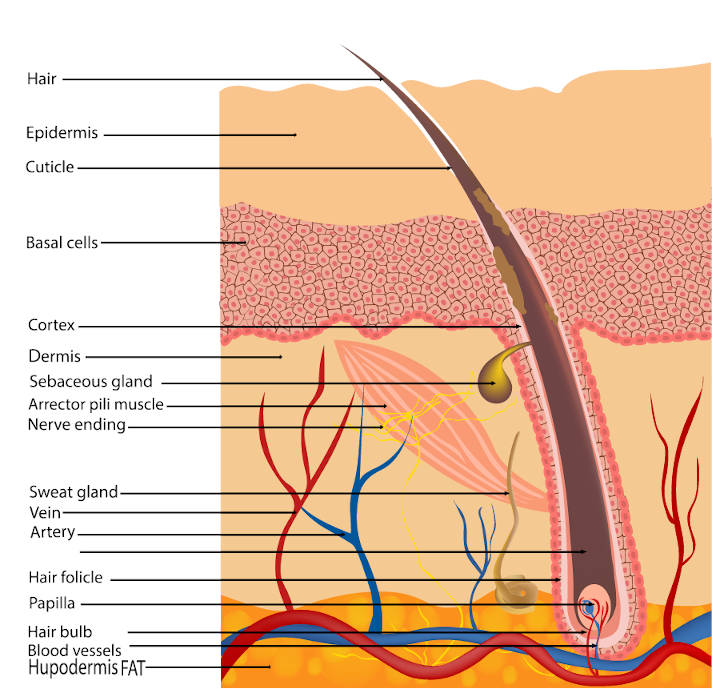
Structure of Hair Diagram
DHT: This is the abbreviation for Dihydrotestosterone. The conversion of testosterone to DHT can lead to male pattern baldness (see Male Pattern Baldness) by stimulating hair loss in DHT sensitive follicles, usually located along the front, top and crown areas of the scalp.
DFU: This is the abbreviation for Di-Follicular Unit Graft. These represent two closely spaced follicular units.
Donor Area: This represents the area from which hair follicles are harvested for transplant. This may be from any hair bearing part of the body, though most commonly is from the safe donor area (see Safe Donor Area) located on the back of the scalp.
Donor Dominance: If a graft is taken from an area not susceptible to androgenic hair loss, such as the safe donor area, then it will be destined to remain permanently hair bearing, after a brief period of effluvian (temporary hair loss due to trauma or shock).
DUPA: This is an abbreviation for Diffuse Unpatterned Alopecia. In this condition there is miniaturization of hair follicles to the point where they no longer produce healthy hair. Since this also affects the safe donor area (see Safe Donor Area), individuals are not candidates for hair transplantation. This is managed non-surgically with Minoxidil (see Minoxidil) and PRP (see PRP).
Dutasteride: This medication blocks both Type I and II 5 alpha reductase and is used off label for androgenetic alopecia (see Androgenetic Alopecia). This blocks nearly all the conversion of testosterone to DHT (see DHT) and can be used in severe cases of male-pattern baldness. It has a higher side effect profile than Finasteride (see Finasteride). Neither medication will work in cases of complete baldness.
Female Pattern Baldness: It is common for women’s hair to thin based on their genetic predisposition. Women usually suffer from diffuse hair loss (see Ludwig), a Christmas tree pattern or male pattern baldness (see Male Pattern Baldness).
Finsateride: Also known as Propecia, this medication is a selective 5 Type II alpha reductase inhibitor and is indicated for androgenetic alopecia. This blocks the conversion of testosterone to DHT (see DHT). The dose of 1mg orally in men is effective in decreasing hair loss by 83% and regrowing hair in 65% of patients. Results usually take 6 to 12 months and recede if the medication is discontinued. Erectile dysfunction can occur in 2% of men, though resolves when medication is discontinued. The medication is available in gel form, though this may not be as efficacious as the oral form.
This may be prescribed in select postmenopausal women at a dose of 2.5mg daily.
Follicle: This describes the hair shaft and accompanying structures, such as sebaceous and sebum glands, the arrector pili muscle, papilla, root sheath and bulb.
Follicular Unit: Some scalp hairs grow as single hairs though most grow in clusters of 2, 3 and sometimes 4 or 5 hairs. These clusters are harvested in the FUE procedure (see FUE). They are likewise separated from each other in the FUT procedure (see FUT) and then replanted.
Frontal Area: This area of scalp is just behind the mid hairline (see Scalp Areas). It is prone to hair loss in Male-Pattern Baldness (see Male Pattern Baldness).
FUE: This is the abbreviation for Follicular Unit Extraction. This is a minimally proven, invasive office procedure where individual hair follicles are harvested and artistically transplanted. The follicles are harvested one at a time using an automated round punch. The main advantage of FUE is for individuals who desire to wear their hair short and avoid the possibility of a visible linear scar. The disadvantage is we must clip the donor area short prior to procedure, though in suitable candidates this can be minimized with the “No Shave FUE” (see No Shave FUE).
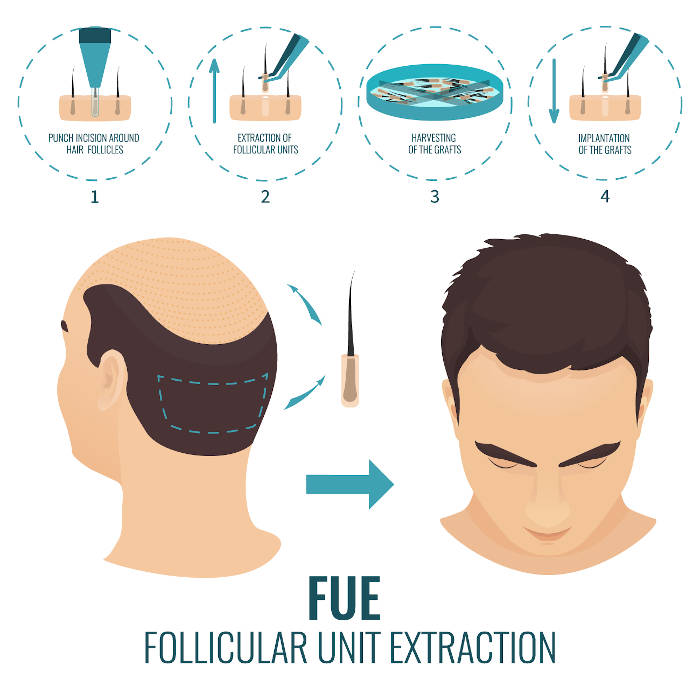
FUT: This is the abbreviation for Follicular Unit Transplant, also known as the “strip procedure”, and is accomplished by removing a narrow (usually ½ to 3/4 inch wide) strip of skin from the back of the scalp. The strip is carefully sliced, or slivered, into thin sheets and the individual grafts are carefully separated and transplanted. Contrary to popular belief, this technique is routinely used and is the most efficient method for harvesting large number of grafts. It also ensures donation from the safe donor area (see Safe Donor Area), unlike FUE which may encroach on the periphery of this zone. Though there is a linear scar, this can be hidden by the overlying hair, selective scar repair or scalp micropigmentation (see Scalp Micropigmentation).
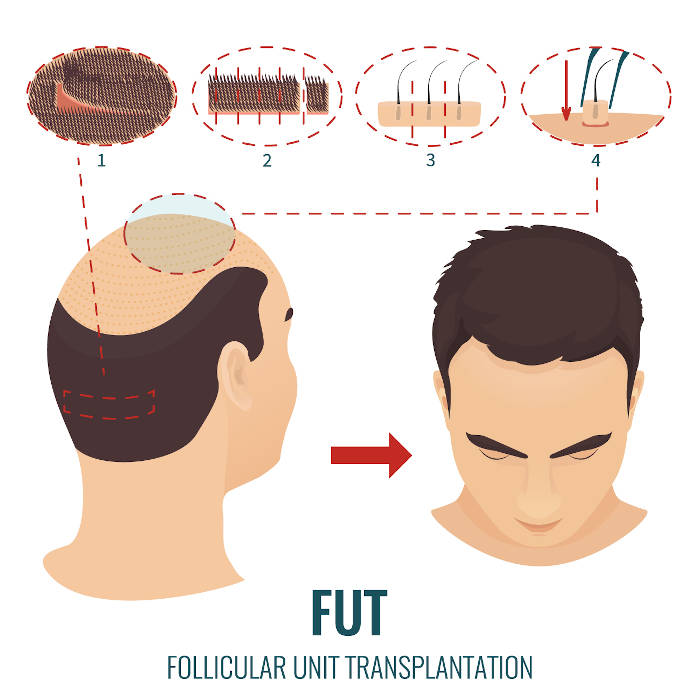
Graft: This usually refers to the tissue being transplanted and usually refers to a single follicular unit (see Follicular Unit).
Hair Systems: These include toupees and wigs for men and women. They are often made of human hair woven into a lace mesh for discrete integration. Hair transplantation can be utilized to transition individuals out of hair systems or reduce the size of the hairpiece.
Low-Level Laser Therapy (LLLT): Sunlight is utilized by the body to stimulate many chemical reactions, such as the generation of vitamin D. Low-level laser red light at specific frequencies can stimulate hair follicles to shift to the anagen phase while decreasing disruptive inflammatory factors. Treatment times are usually less than 15 minutes several times weekly and results are usually seen in 6 months. This treatment can be used in combination with both surgical and non-surgical therapies with essentially no side effects.
Ludwig Scale: This a classification system for female pattern baldness (see Female Pattern Baldness) and ranges from I to III. In Stage I there is diffuse thinning on the top of the head. In Stage II there is greater diffuse thinning. By Stage III, there is severe diffuse thinning with visible scalp and all the hair on the crown may be lost. Not all women fit this classification system.

Male Pattern Baldness: This is also known as androgenetic alopecia (see Androgenetic Alopecia). DHT (see DHT) sensitive hair follicles begin to miniaturize and then are lost over along the frontal, temporal, central and crown areas of the scalp.
Miniaturization: This is a form of hair loss wherein the thick terminal hairs (see Terminal Hairs) slowly become thinner and more transparent, or vellus hairs (see Vellus Hairs). These hairs eventually disappear leading to complete baldness.
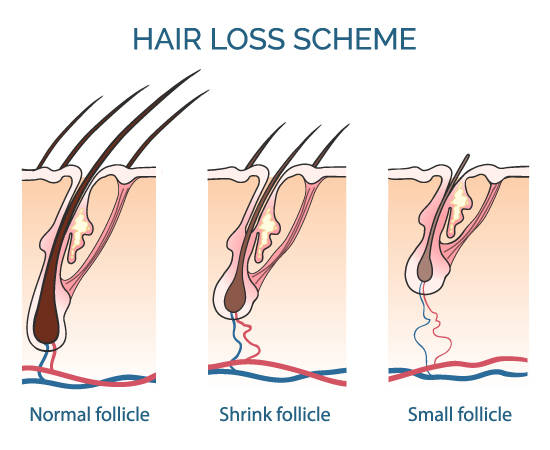
Minoxidil: This topical medication, trade name Rogaine (see Rogaine), is used in both men and women to slow down and reverse, but not entirely stop the process of male and female pattern baldness. It is applied topically twice daily in doses of 5% for men and either 2% or 5% for women. Hair growth can be seen in as little as 4-6 weeks. There may be scalp irritation. Minoxidil can be used in combination with Finasteride, PRP, LLLT and other therapies for combined effect. The hair growth reverses if the medication is discontinued.
No Shave FUE: FUE typically involves in trimming, or shaving, the donor area to about 1/8”. This technique involves shaving several strips in the safe donor area (see Safe Donor Area) and hiding the donor area with longer hair draped from above.
Noorwood Classification: This 7-stage scale was originally developed in the 1950’s and is used by physicians to document the severity of male baldness. It can also serve as a template to guide hair restoration planning.
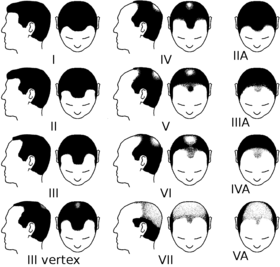
Plugs: Hair plugs, now outdated method of hair transplantation, involved taking 4-mm round punch grafts containing 16 to 20 hairs and relocating them to the recipient site. This left the individual with an unnatural look, similar to “Barbie Doll Hair Plugs”. Modern day hair transplantation involves transplanting single follicular units.
Propecia: Trade name for oral Finasteride (see Finasteride) used to medically treat male pattern baldness.
PRP (Platelet-Rich Plasma): After an injury, platelets are the cells that release growth factors to signal the body to mobilize fibroblasts, macrophages and other cells to quickly heal the injury. PRP involves drawing 40 to 60cc of your blood and by using high speed centrifuges, separating the platelets and growth factors from the red blood cells. This is injected in the area of thinning hair to stimulate the follicles to grow, thicken and remain in the anagen phase longer, giving the net effect of increased hair density. Typical treatment regimens include several monthly sessions followed by a maintenance program quarterly. PRP may also be administered at time of FUE or FUT and may be used in combination with other non-surgical therapies.
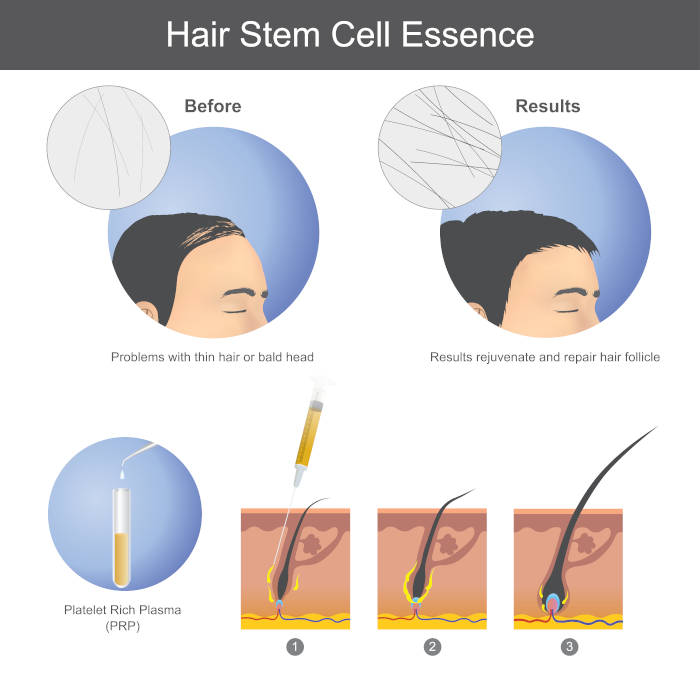
Rogaine: This is the trade name for Minoxidil (see Minoxidil).
Recipient Dominance: Usually the transplanted grafts retain their original growth characteristics based on the theory of donor dominance (see Donor Dominance). However, sometimes the donor grafts will adopt characteristics of the recipient site and alter their growth. This can occur with eyelash transplantation.
Recipient Sites: These are small slits (usually 0.8 to 1.2mm) made in the skin or scalp to receive the grafts (see Graft). These should be artistically angled to recreate a natural look.
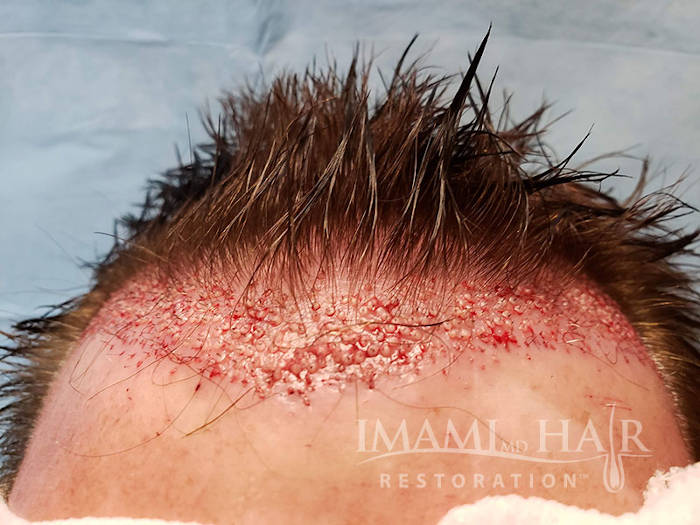
Safe Donor Area: This is the area on the lower back and sides of the scalp where the hair follicles not sensitive to DHT related hair loss. This donor area (see Donor Area) is the preferred source of grafts since they are unlikely to bald due to the theory of donor dominance (see Donor Dominance).
Scarring Alopecia: In this condition, scarring causes irreversible damage to hair follicles. This could be related to trauma, autoimmune or inflammatory conditions of the scalp. Diagnosis is often made by a small skin biopsy. Failure to accurately diagnose these conditions will lead to transplant failure.
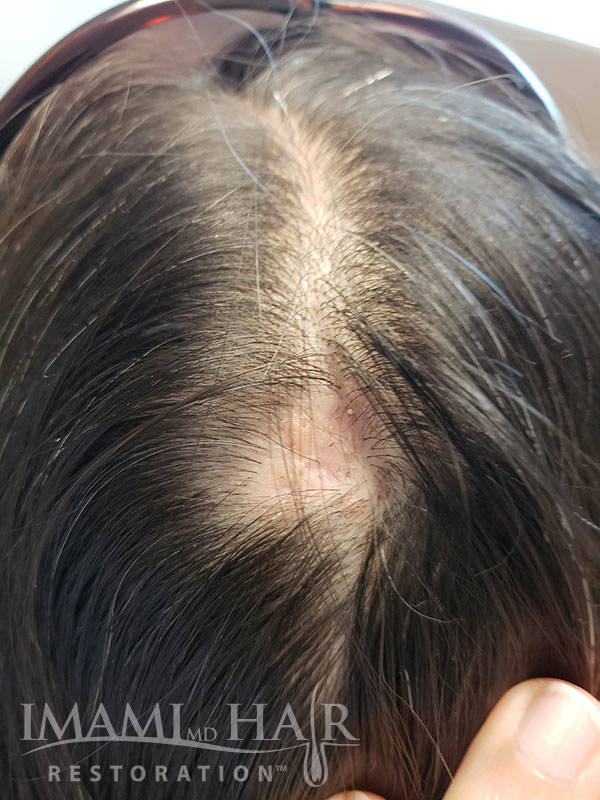
Scalp Areas: The skin overlying the scalp can be divided in several zones for purposes of hair loss and transplantation. The Frontal Area (F) is just behind the mid hairline. The Temples (T) are lateral to the frontal area. The Midscalp (M) is the larger area on the topmost portion of the head. The Vertex (V) is also known the crown on the posterior top of the head.
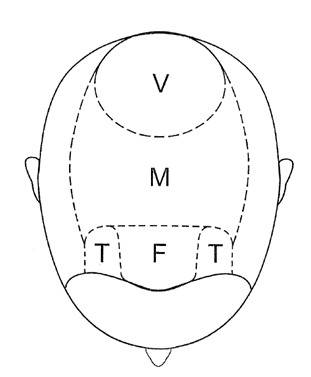
Scalp Micropigmentation (SMP): Also known as SMP, is an artistic tattooing process that uses a fine micro-needles and matching hair color dye to give the illusion of fuller hair. It does not damage existing hair and can also be used to conceal scars. SMP can be added to hair transplantation for a fuller look.
Shock Loss: This phenomenon can occur 2 – 8 weeks after hair transplantation and involves the temporary shedding of adjacent hairs. The loss occurs after trauma, surgery and sometimes the anesthetic used to numb the scalp. Recovery usually occurs within 3 – 6 months.
Telogen Effluvium: This is a temporary form of hair loss usually occurring weeks to months after stressors such as surgery, anesthesia, pregnancy, generalized illness or injury. Under extreme stress, up to 70% of the hairs can shift from the anagen growth phase to the telogen resting phase. This usually occurs on the top of the scalp and is not an indication for hair transplantation.
Temporal Area: This area of scalp is on along the front portion of both sides of head lateral to the frontal area (see Scalp Areas). It is very prone to hair loss in Male-Pattern Baldness and is one of the first areas to recede.
Midscalp Area: This area of scalp is the larger area on the topmost portion of the head (see Male Pattern Baldness and Female Pattern Baldness).
Terminal Hairs: These are mature thick hairs individuals have before the onset of androgenetic alopecia and miniaturization (see Miniaturization) of thick hairs into vellus hairs (see Vellus Hairs).
Traction Alopecia: This is a non-scarring form of gradual hair loss primarily from pulling forces on the hair. Often seen in African American women who wear their hair tight in a ponytail, pigtails or braids. This can be treated with hair transplantation if there is adequate donor hair.
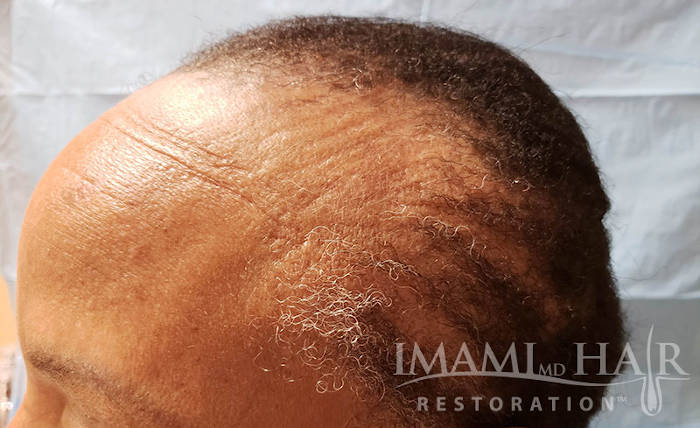
Trichophytic Closure: This incision closure technique minimizes the appearance of the linear after FUT (see FUT). By trimming one wound edge, the underlying hair shafts grow directly through the donor scar rendering it discrete.
Trichotillomania: An obsessive-compulsive disorder wherein individuals have a recurrent irresistible urge to pull out their scalp, eyebrow, eyelash and other body hair.
Vellus Hairs: These are short, thin lightly colored and barely noticeable hairs seen over the body during childhood. Typically, many of these mature into terminal hairs (see Terminal Hairs) during puberty. With miniaturization (see Miniaturization), the terminal hairs can revert to vellus hairs and eventual balding.
Vertex (Crown): The Vertex of the scalp is also known the crown on the posterior top of the head.
Whorl: This is a patch of hair that is growing in a circular direction around a visible point. This occurs on the crown and be either clockwise or counterclockwise.
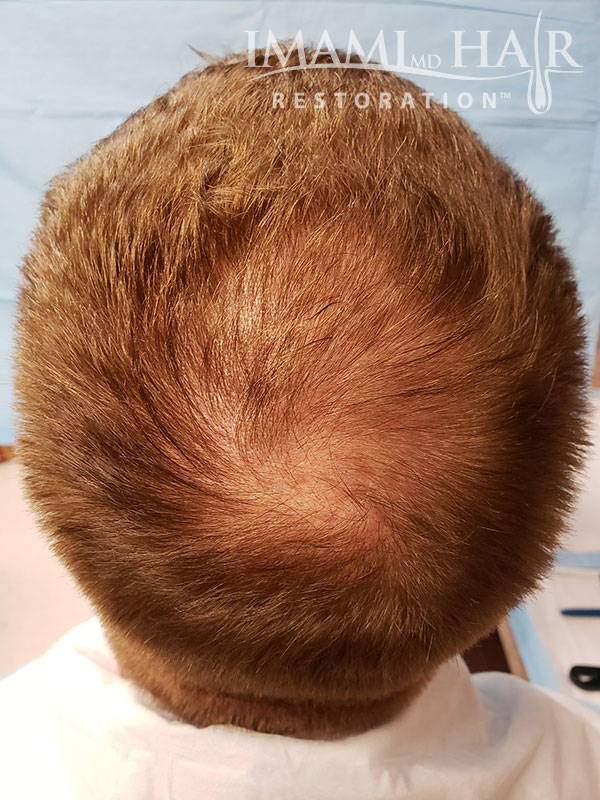
Experience Healthy, Thicker Hair
"*" indicates required fields
